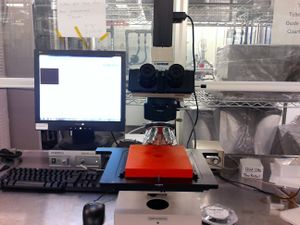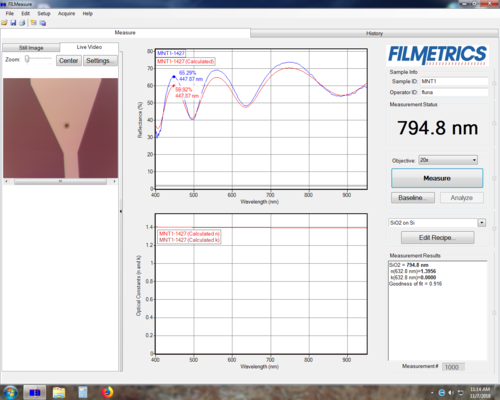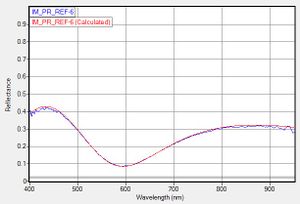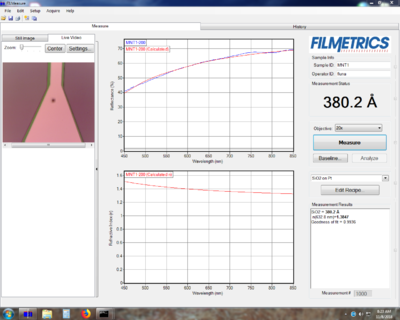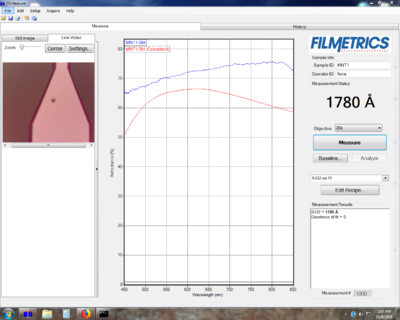Difference between revisions of "Filmetrics F40-UV Microscope-Mounted"
(removed "screenshots" section --> "Examples") |
(→About: add BHJML model) |
||
| Line 9: | Line 9: | ||
}} |
}} |
||
| − | == |
+ | ==About== |
| − | The Filmetrics F40-UV is a microscope-mounted thin-film measurement system, allowing you to non-destructively measure thin-film thicknesses in small (patterned) areas on your sample. It is an optical reflectometer, acquiring reflection spectra between 400-900nm optical wavelengths (Vis to Near-IR) with a regular halogen microscope light source. The Filmetrics software then performs curve-fitting to determine the thickness and/or refractive index of the measured films. |
+ | The Filmetrics F40-UV is a microscope-mounted thin-film measurement system, allowing you to non-destructively measure thin-film thicknesses in small (patterned) areas on your sample. The microscope is a standard Olympus BHJML metallurgical trinocular microscope. It is an optical reflectometer, acquiring reflection spectra between 400-900nm optical wavelengths (Vis to Near-IR) with a regular halogen microscope light source. The Filmetrics software then performs curve-fitting to determine the thickness and/or refractive index of the measured films. |
| − | == |
+ | ==Capabilities== |
| ⚫ | |||
| ⚫ | |||
| ⚫ | |||
| ⚫ | |||
| ⚫ | |||
| ⚫ | |||
| − | == Operating Procedures == |
||
| ⚫ | |||
| ⚫ | |||
| ⚫ | |||
| ⚫ | |||
| ⚫ | |||
| − | == |
+ | ==Operating Procedures== |
| ⚫ | |||
| ⚫ | |||
| + | |||
| + | ==Examples== |
||
| + | |||
| ⚫ | |||
Do not believe your thickness measurements unless the red/blue curves show a reasonably good match![[File:Filmetrics_F40-UV_-_Measurement_screenshot_on_metal_pad_01.PNG|alt=example spectrum curve fit|none|thumb|500x500px|Screenshot showing 10x microscope view and optical spectrum/curve fitting of the SiO2 film thickness on top of Platinum contact metal.]] |
Do not believe your thickness measurements unless the red/blue curves show a reasonably good match![[File:Filmetrics_F40-UV_-_Measurement_screenshot_on_metal_pad_01.PNG|alt=example spectrum curve fit|none|thumb|500x500px|Screenshot showing 10x microscope view and optical spectrum/curve fitting of the SiO2 film thickness on top of Platinum contact metal.]] |
||
[[File:Filmetrics F40-UV - spectrum curve fit 07.jpg|alt=example spectrum curve fit|none|thumb|300x300px|A good fit should show the Calculated (red) curve overlay on top of the Measureed (blue) curve.]] |
[[File:Filmetrics F40-UV - spectrum curve fit 07.jpg|alt=example spectrum curve fit|none|thumb|300x300px|A good fit should show the Calculated (red) curve overlay on top of the Measureed (blue) curve.]] |
||
| − | === |
+ | ===Checking whether a dry etch is complete=== |
The F40-UV is very useful for measuring whether a thin-film has been completely removed during a dry etch. This is similar to using [[Laser Etch Monitoring|laser monitoring]] during the etch, except that the microscope enables you to measure inside small patterned areas that a laser monitor spot may not fit inside. |
The F40-UV is very useful for measuring whether a thin-film has been completely removed during a dry etch. This is similar to using [[Laser Etch Monitoring|laser monitoring]] during the etch, except that the microscope enables you to measure inside small patterned areas that a laser monitor spot may not fit inside. |
||
Revision as of 10:48, 22 January 2020
|
About
The Filmetrics F40-UV is a microscope-mounted thin-film measurement system, allowing you to non-destructively measure thin-film thicknesses in small (patterned) areas on your sample. The microscope is a standard Olympus BHJML metallurgical trinocular microscope. It is an optical reflectometer, acquiring reflection spectra between 400-900nm optical wavelengths (Vis to Near-IR) with a regular halogen microscope light source. The Filmetrics software then performs curve-fitting to determine the thickness and/or refractive index of the measured films.
Capabilities
- Measure optically transparent thin-films down to ~30nm thickness.
- Microscope Objectives: 10x, 20x, 50x, 100x, 150x
- Acquire Optical Reflection Spectra from 400-900nm
- Spectrometer/Detector is capable of detecting down to UV ~190nm, but light source does not support this wavelength.
- Reflectivity curve-fitting for thin-film thickness analysis, supporting many common materials (Si3N4, SiO2 dielectrics, Si, GaAs, InP semiconductors, metals, photoresists etc.)
Operating Procedures
Examples
Good Curve-Fitting
Do not believe your thickness measurements unless the red/blue curves show a reasonably good match!
Checking whether a dry etch is complete
The F40-UV is very useful for measuring whether a thin-film has been completely removed during a dry etch. This is similar to using laser monitoring during the etch, except that the microscope enables you to measure inside small patterned areas that a laser monitor spot may not fit inside.
In the following example, we are trying to etch away the SiO2 from on top of a Platinum contact metal. The 20x objective allows us to measure the SiO2 thickness on top of the Platinum as we continue to etch in 1 minute increments, measuring in between etches.
Finally, when the SiO2 has been fully removed, we see that we can't get a good fit between the measured (blue) and simulated (red) data.
Since the Platinum layer is thick enough to be opaque to visible light (>50nm), we just modelled this as SiO2 on top of Platinum, ignoring any other materials below the platinum.
